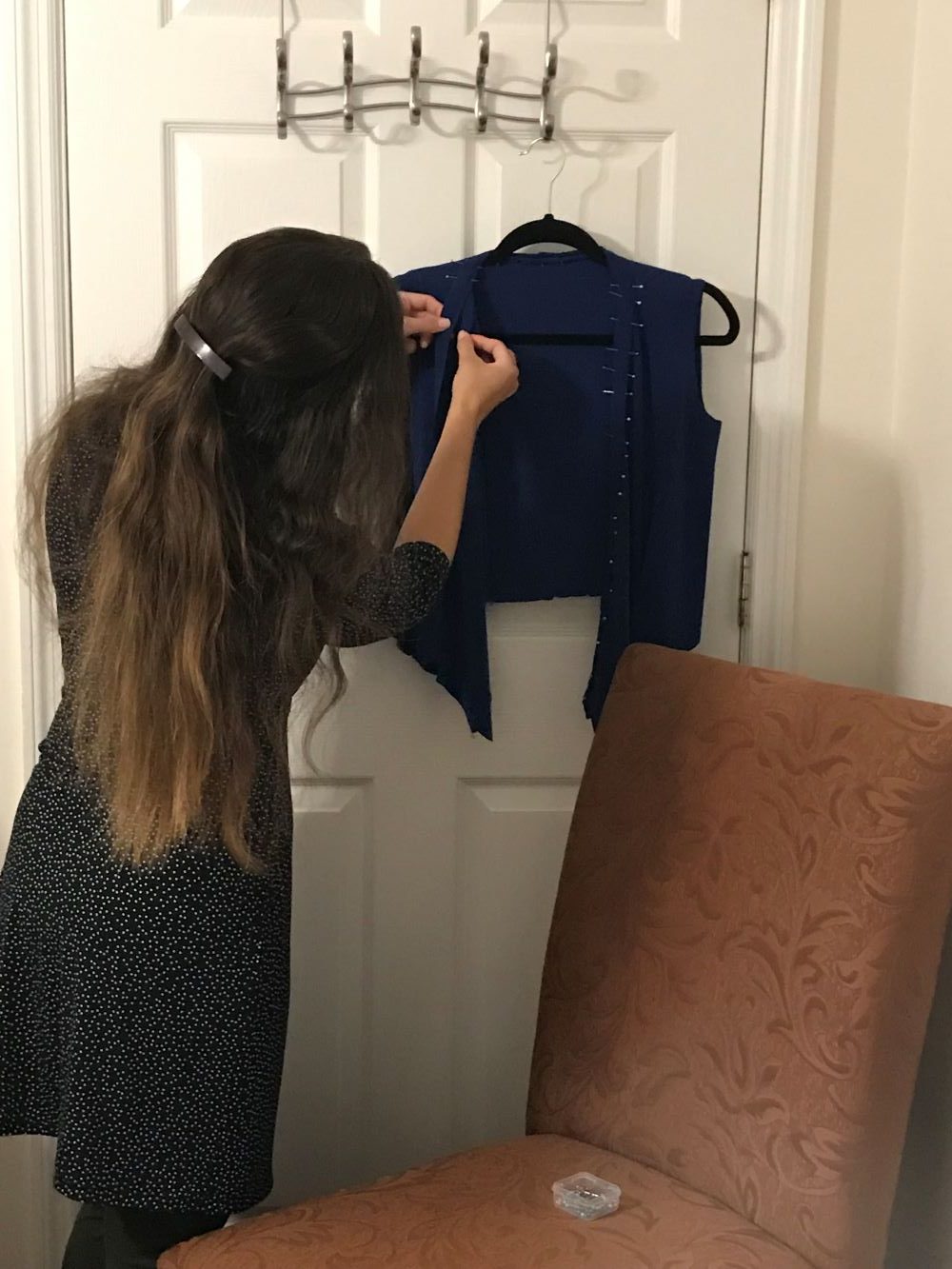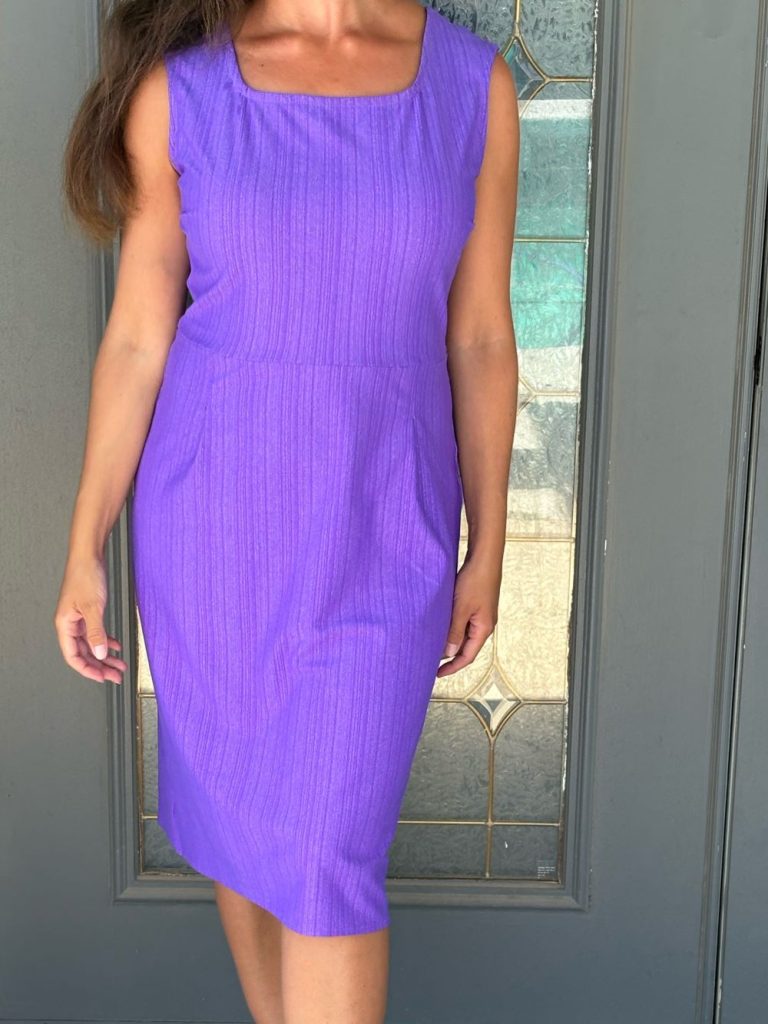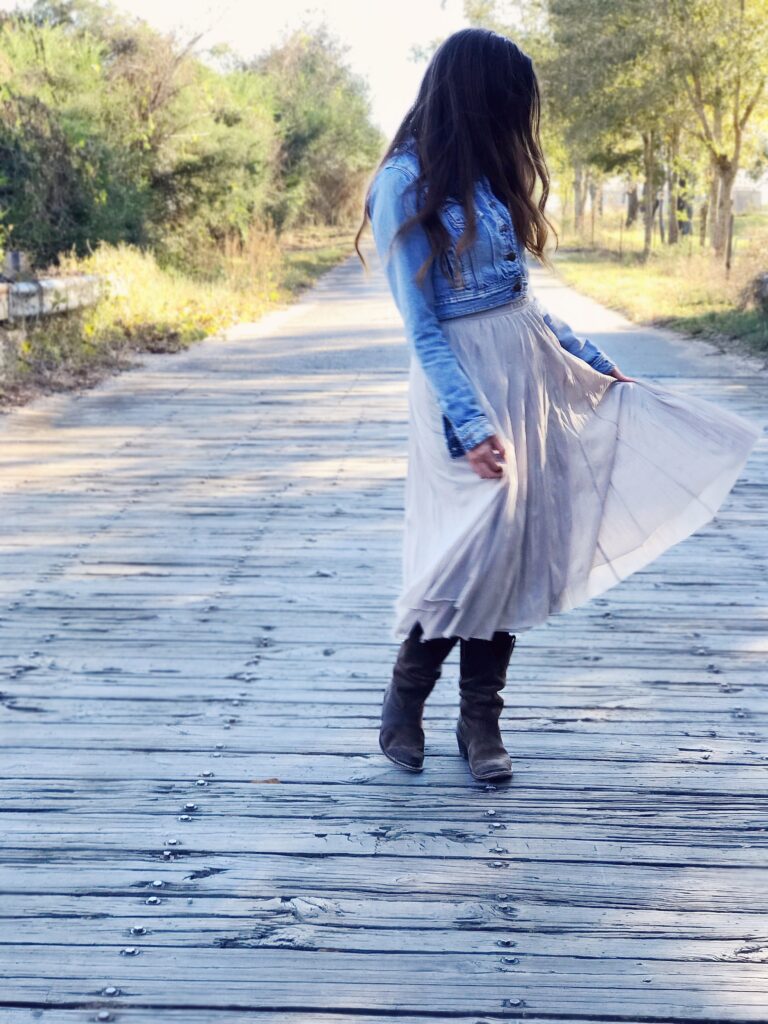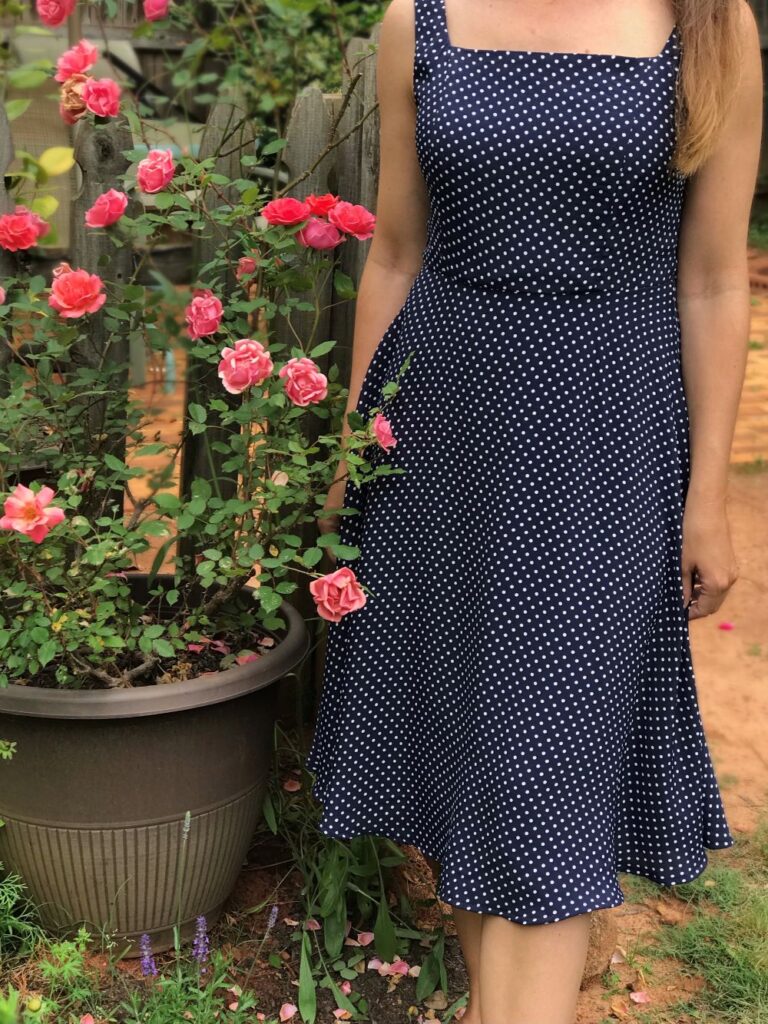
Ladies,
For any of you who have wanted to start sewing or have started, I want to share my experience with learning to sew for your benefit. I would also love for other ladies to share their experiences of starting to sew in the comments below for the readers benefit.

Sewing is a Solitary Craft
Those of us who sew garments know this, while perhaps quilting is somewhat different as I know quilters will actually get together to sew. But as for dressmaking, I have never known anyone to do this in a group setting. We do not lug our machines, fabric, thread, patterns and assortment of tools around to people’s houses or an establishment to do this together. Lugging these things around would not be easy. The aforementioned items are not a few in number, nor can it be when you will need access to many different things to complete any project. The reason I mention this is because that is part of the fun of it. Sewing can be a peaceful activity and a time to enjoy being immersed in your creative endeavor.
A Place to Sew
Physical space. This is why women have whole sewing rooms dedicated to this. They are not being over-the-top, they are being practical. Sewing requires many different tools, places to store them, and space to move around pattern pieces doing measuring, cutting, etc. This craft requires a large table or a large floor space for spreading out patterns and fabric. You will need a desk or table for your machine and a chair to sit comfortably at it. You will need drawers, cupboards and bins to store supplies. Fabric, even a small amount of fabric takes up a lot of space. Patterns take up a lot of space. Once you take the inserts out, they will fold back into the packet with great difficulty and will inevitably be thicker the way you fold it back in vs how the factory had it folded in. This makes the packets take up even more space for storing. If you trace your sewing patterns to preserve the original, the pattern pieces you painstakingly trace will now need to be stored well to preserve them. To trace your patterns, you will need rolls of tracing paper that will also need to be stored. Not to mention that sewing requires multiple kinds of pens, pencils, markers, chalk, scissors, measuring tapes and sticks, and pins. Not to mention hangers and places to hang garments like in a closet or multiple hooks secured in the wall or on the back of a door. You will even need a full length mirror in the room where you sew so that you can try on garments throughout the process and see them on your body.
Beyond needing to store items and move around your project freely, it is very beneficial to have the ability to close off your sewing room from the rest of the household. This will prevent pets from ruining delicate tissue paper, to them getting hurt on sharp sewing tools or hot irons, and that goes for babies and children as well. Aside from them getting hurt, pets and small children weaving in and around things can be a liability to your project. Also, it can be helpful to keep people out during certain difficult parts of the project so that you can focus.
Time to Focus
Learning how to sew and then sewing even after you have learned how, takes time to focus. Any project you make for the rest of your life will require you to study that particular project and the steps necessary to complete it. You never stop learning with sewing because every single project requires different techniques and different fabric. But you need time to focus on each individual step. You need time to make sure you are doing the steps in order. I like to say “it takes every single one of my brain cells to do this”. That is how it feels for me. I literally need to be alone in a quiet room with time to focus. I could never do this with noise or people around. As you get better at sewing, you can sew with less stress but you will always need time to focus as any misstep will require you to backtrack by stitch ripping to redo it. My goal when sewing is to stitch rip nothing or very little, so I sew slowly and deliberately to save myself this frustration and one thing that has helped me is to give myself time to focus on each step. This may mean you sew when babies or children are sleeping or playing quietly or outdoors. This may mean you can only do one or two steps at a time before you get interrupted. This includes interrupting yourself to get dinner started! It can be difficult to have large spans of time to just sew but you can still do it in small batches of time. Sewing takes time and it takes focus, so whenever you get even a small time to sew, use that time to fully focus on that next step.

Sewing is Difficult
I do not say this to discourage you but to encourage you. Anyone can sew and I do not want to make it sound daunting because I want you to know that you can do it. But it felt good to finally hear one person online admit that sewing is difficult. Okay, so it’s not just me?! It is engineering. It is measuring, it is being exact in every facet of the process so that nothing goes wrong. It means doing everything correctly because everything affects something else down the line. It means knowing the correct order of steps because it will matter 15 steps from now. It means using the correct stitch length, the right tension on the machine, etc. Fitting alone can be difficult, which is why many seamstresses make many mock ups (known as “toiles” or “muslins”) of their project before cutting into their special fabric. Not to mention learning the different kinds of seams and when to use them, learning how to treat fabric and how to cut it better for better drape and balance.
Behind every cool as a cucumber seamstress online is a history of tears and blood from pricking her fingers and stitch ripping. The fact that sewing is “difficult” varies from project to project. There are easier beginner friendly projects that will not be as difficult. But you will find as you keep sewing that there were details you missed in those projects because if you were told all of the details up front even about something “easy” you would probably be overwhelmed. But you certainly can still make something that looks nice. We all need to start somewhere! Don’t be afraid to dive in! But the better you get at sewing the more you will look at your first projects and see how much you did not yet know. That is ok. Because sewing is difficult.

Sewing is Engineering
Sewing is extremely technical. If I have not already emphasized this point enough, I will emphasize it again. I was shocked at how much engineering I had to do to with every single pattern to get it right for my body. I had no idea that a sewing pattern is not simply sewn up in a size that will fit me. That is not how this works. You have to use the sewing pattern as your guide and manipulate it to work for your particular body. Very few seamstresses are sewing garments as the pattern comes in the packet. Most of us are using paper and adding in height under the arm pit, or raising a neckline, or pinching out certain areas that are too big or widening areas that are too small. Many of us are sewing to begin with because we have fit issues with store bought clothing. As a petite woman, I have a set of standard changes I have to make to every single pattern but every pattern is different so I have to study each individual pattern to know exactly what to do. I have spent a significant amount of time learning how to change sewing patterns and it is very technical. It involves measuring devices of all kinds to get curves and angles correct. It involves taping and tracing paper and pencils. This is a feat of engineering to get a sewing pattern made to fit you. Just the fact that you will most likely not be one size in a single pattern, but several sizes for one garment is important to understand. Meaning, you will trace or cut one size for the armholes, another size for the bust, another size for the waist, etc. So visualize with me here, one panel of a dress front: if you are tracing over it on paper or cutting out the pattern, you will start at one size and move through that one panel to different sizes at different points of the body. Crazy, right? That’s how sizing properly actually works with sewing patterns. Very few people are just one size in anything.
You Actually Sew Very Little
You may be shocked to find that you actually sew very little and most of the process of “sewing” is measuring yourself, measuring pattern pieces, cutting or tracing patterns, pairing fabric with patterns, reading patterns, washing and ironing fabric, pinning, etc. I use to joke that sewing should be called “pinning” because that’s what I felt like I did more than anything. But the more I sewed the more I began learning how my garments should fit properly so I was tracing and pattern engineering more than anything. Now I feel like all I do is iron fabric because that is something that became more important to me to make the garment look of highest quality. The point is, when you finally get to the step of actual sewing, you realize that very little of your time was spent sewing.
Sew What You Love
I began with this fact: you will be sewing alone as it is an isolated activity. Know this too, you are not putting all of this effort and time into this to wear something you don’t like. Sew something that you want to wear, sew something that you think is beautiful. That can be a journey in and of itself and dedicating a significant amount of time and effort into something helps you realize real fast what is actually worth it to you. That doesn’t mean you will not make duds. I have sewn many dresses that I ended up donating because you can’t always know how something will look until you make it.
Sewing can be a way you realize what you really like even though that means making some you won’t like. Use that to your advantage to learn what to do better next time.
Identify Your Priorities vs Other People’s
As I was sewing I realized that a lot of women were making dresses without lining them. It made me ask myself if I was making a mountain out of a mole hill. But I truly have a dislike of see-through garments. I also do not want to have to wear a slip with everything. I dislike layering. I want to put on one item and be done because that feels most comfortable to me.
When you expose yourself to other people’s sewing online, you will learn very quickly that things that matter to you, which may even be the reason you decided to make your own clothes, are not things other seamstresses care to do. You will probably question if you should even be lining all of your dresses, or doing this or that and after some reflecting on the matter, hopefully you come out the other side identifying your priorities vs other people’s and doing what matters to you. We sew because we get to customize everything to our preferences, not someone else’s.
Sewing is Expensive
There are a lot of costs involved with sewing. You will need good quality tools. This adds up, so I advise that you start as minimally as possible and if your interest grows in it, then collect better and more things that you will need. If you picked the perfect pattern and it was on sale and the perfect fabric and it was on sale every single time and you got a garment that you loved every single time….yes you are saving money vs buying store bought clothing. But that is not how sewing works, especially as a beginner. You will make choices that you do not end up liking. You will realize you dislike certain patterns or certain fabrics and you already spent money on it and you already spent time and effort making it. Learn to use those mistakes as part of the learning process instead of viewing it as a waste of money. Without mistakes, you will never learn. You have to make garments to get better and that means spending money and not liking it or wearing it. But that’s what it takes. So it does take spending a lot of money to make mistakes. In theory and as you get better at making clothing, you can save money. I technically have a lot of inexpensive dresses because the fabric cost me less than $50 for that one dress. It also took me months to make it. It also took me 5 dresses that I did not like and donated or threw away to get to one I did like.
It is Worth it
I had sewn a little bit as a young girl. I was given basic instruction and I made over 100 hair scrunchies to sell at the church Christmas craft bazaar as well as one pair of pajama shorts which won me a blue ribbon in the fair that year in the 4H club. This exposure to using the sewing machine, threading the machine and working with fabric benefited me greatly to learn more later in life. Way later in life, as I did not learn how to sew anything else until I was 38 years old. I could mend, resize and hem store bought clothing but I did not learn to sew from a sewing pattern or make a garment from beginning to end until I was 38 years old.
In our society, we tend to think that people are washed up at certain ages. God has gifted us time and He has given us good things to enjoy and things to bless others and ways to serve Him. I wanted to know how to sew a dress my entire life and that did not happen until much later on and that’s ok! Maybe you want to just sew a little or maybe you want to become an expert. You can learn it.
This is a skill that will bless your husband and children as well. You can sew right at home and it is wonderful to have such rewarding interests without having to be away from our homes. They will get to see you work and maybe be blessed to have this skill passed on to them. They will get to see you wear beautiful custom things. Maybe they will get to wear something you made for them too, or enjoy something you made for the home. Maybe they will just be able to ask for your help in sewing a button back on or mending a hole. Just the skill of mending will save you money, make you feel accomplished and bless your family.
WHATEVERLOVELY.com
CHRISTIAN LIVING – FASHION – HOME





Leave a Reply